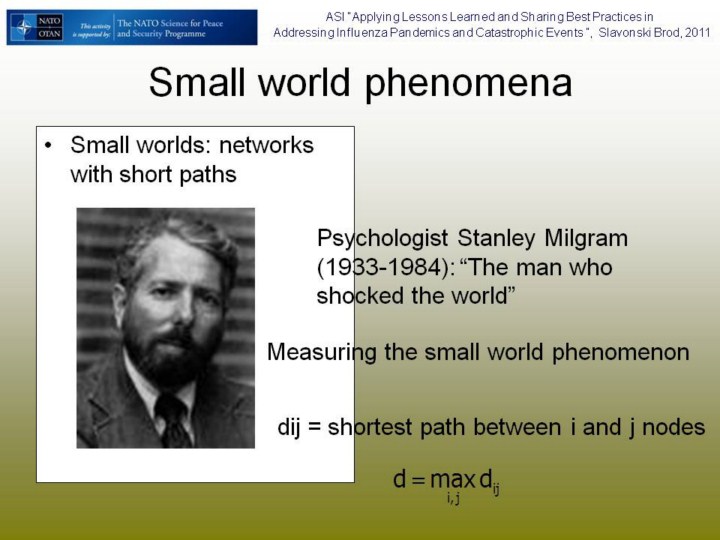| front |1 |2 |3 |4 |5 |6 |7 |8 |9 |10 |11 |12 |13 |14 |15 |16 |17 |18 |19 |20 |21 |22 |23 |24 |25 |26 |27 |28 |29 |30 |31 |32 |33 |34 |35 |36 |37 |38 |39 |40 |41 |42 |43 |44 |45 |46 |47 |48 |49 |50 |51 |52| 53| 54 |review |
 |
The small world experiment comprised several experiments conducted by Stanley Milgram examining the average path lengthfor social networks of people in the United States. The research was groundbreaking in that it suggested that human society is asmall world type network characterized by short path lengths. The experiments are often associated with the phrase "six degrees of separation," although Milgram did not use this term himself
Milgram's study results showed that people in the United States seemed to be connected by approximately three friendship links, on average, without speculating on global linkages; he never actually used the term "six degrees of separation." Since thePsychology Today article gave the experiments wide publicity, Milgram, Kochen, and Karinthy all had been incorrectly attributed as the origin of the notion of six degrees; the most likely popularizer of the term "six degrees of separation" would be John Guare, who attributed the value 'six' to Marconi. Several studies, such as Milgram's small world experiment, have been conducted to empirically measure this connectedness. While the exact number of links between people differs depending on the population measured and the types of links used, it is generally found to be relatively small. Hence, the phrase "six degrees of separation" is often used as a synonym for the idea of the "small world" phenomenon. However, detractors argue that Milgram's experiment did not demonstrate such a link,[9] and the "six degrees" claim has been decried as an "academic urban myth".[10]. Also, the existence of isolated groups of humans, for example the Korubo and other native Brazilian populations[11], would tend to invalidate the strictest interpretation of the hypothesis
Kleinberg is best known for his work on networks and particularly for his HITS algorithm, developed while he was at IBM. HITS is an algorithm for web search that builds on the eigenvector-based methods used in algorithms and served as the full scale model for PageRank by recognizing that web pages or sites should not only be considered important (as in PageRank) if they are linked to by many others, but also if they link to many others. Search engines themselves are examples of sites that are important because they link to many others. Kleinberg realized that this generalization implies two different classes of important web pages, which he called "hubs" and "authorities". The HITS algorithm is an algorithm for automatically identifying the leading hubs and authorities in a network of hyperlinked pages. Kleinberg is also known for his work on algorithmic aspects of the small world experiment. He was one of the first to realize thatStanley Milgram's famous "six degrees" letter-passing experiment implied not only that there are short paths between individuals in social networks but also that people seem to be good at finding those paths, an apparently simple observation that turns out to have profound implications for the structure of the networks in question. |